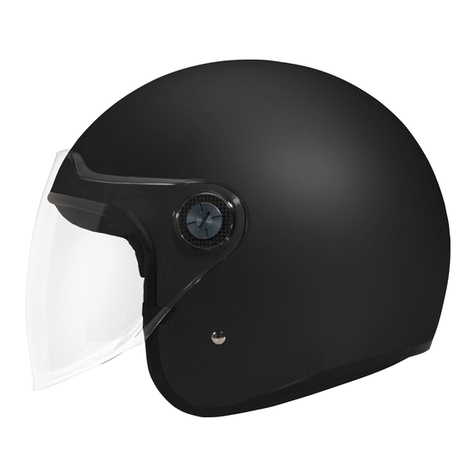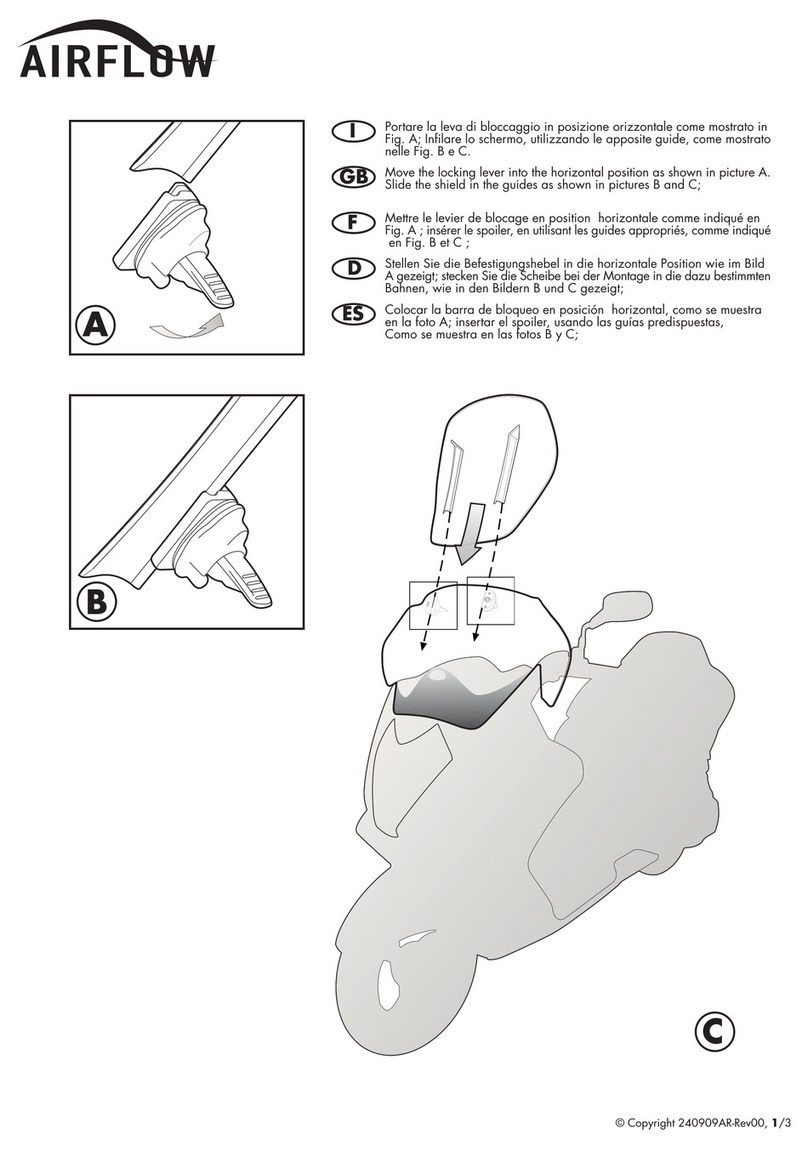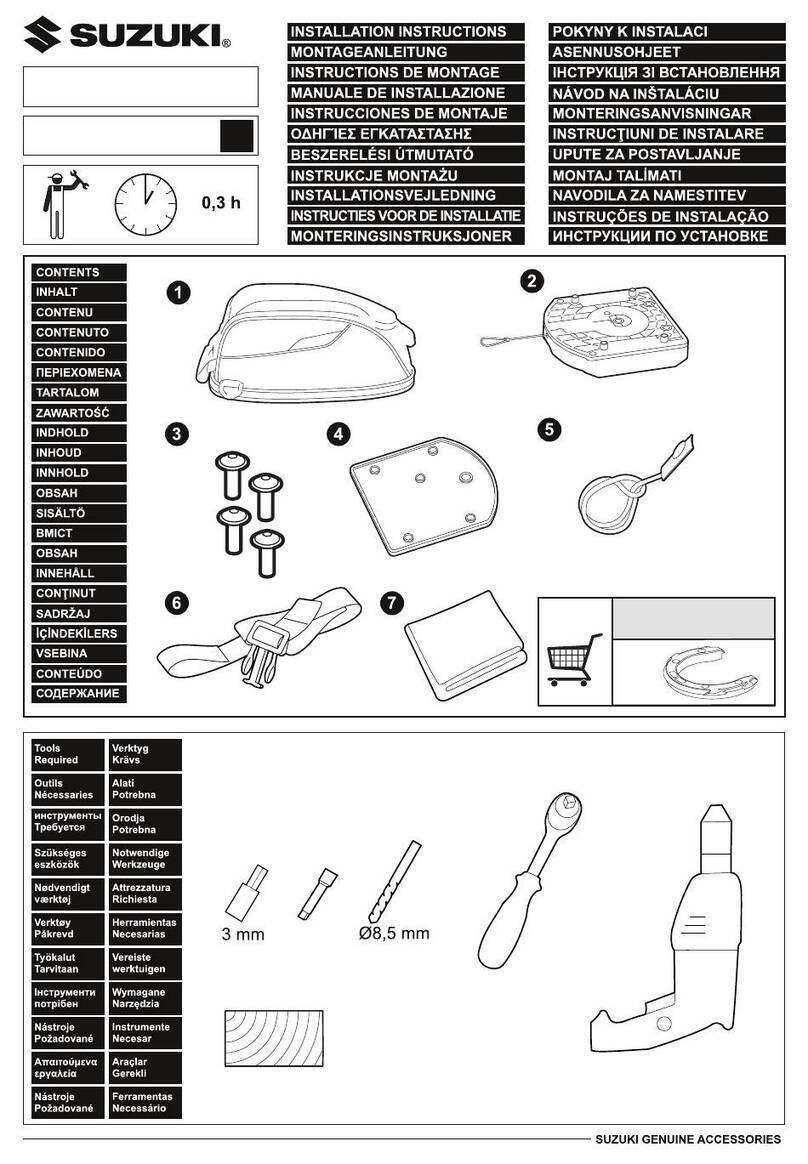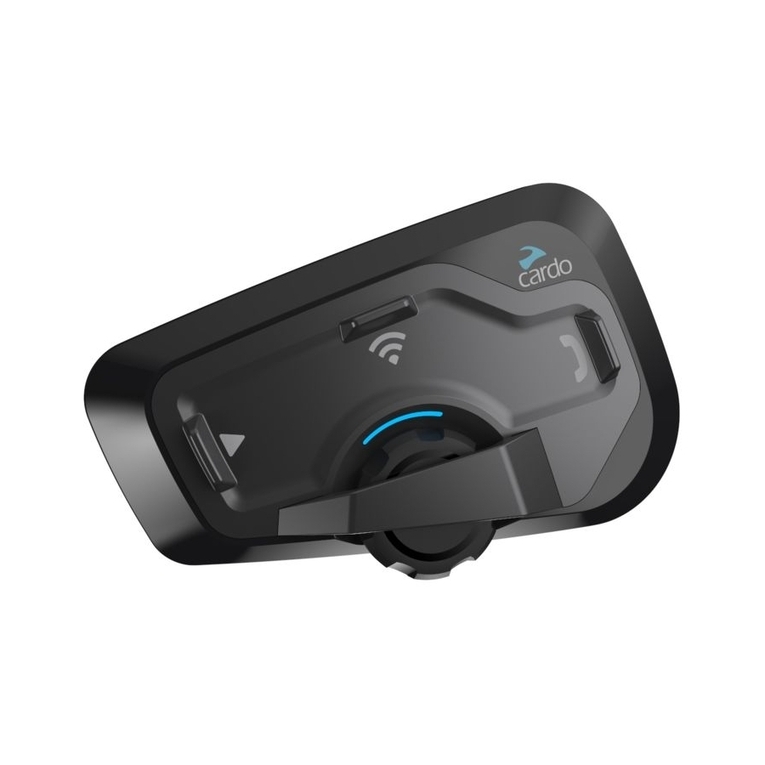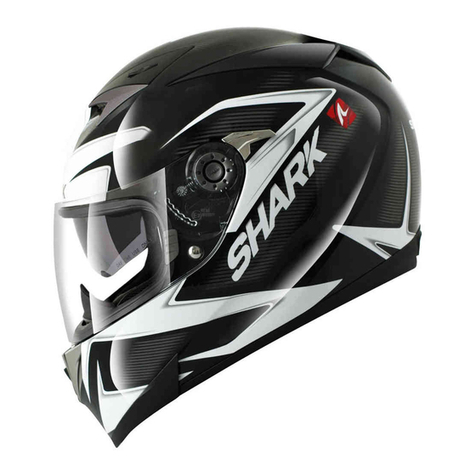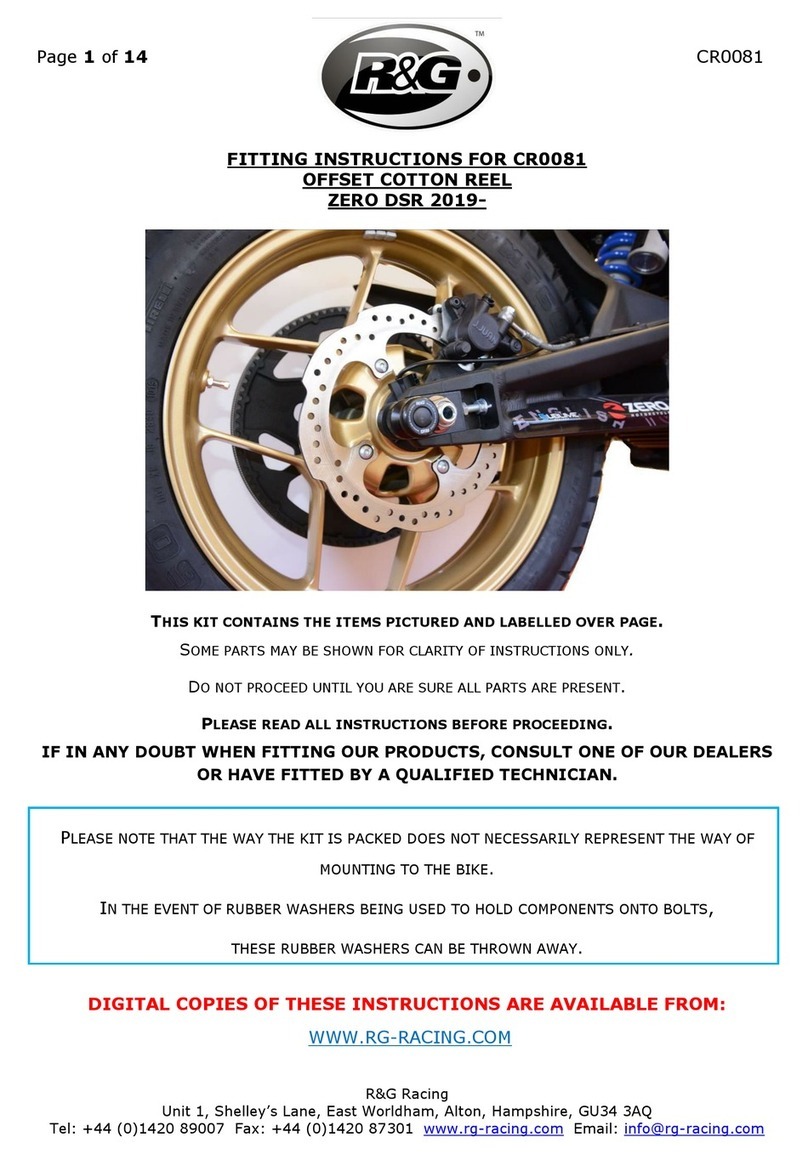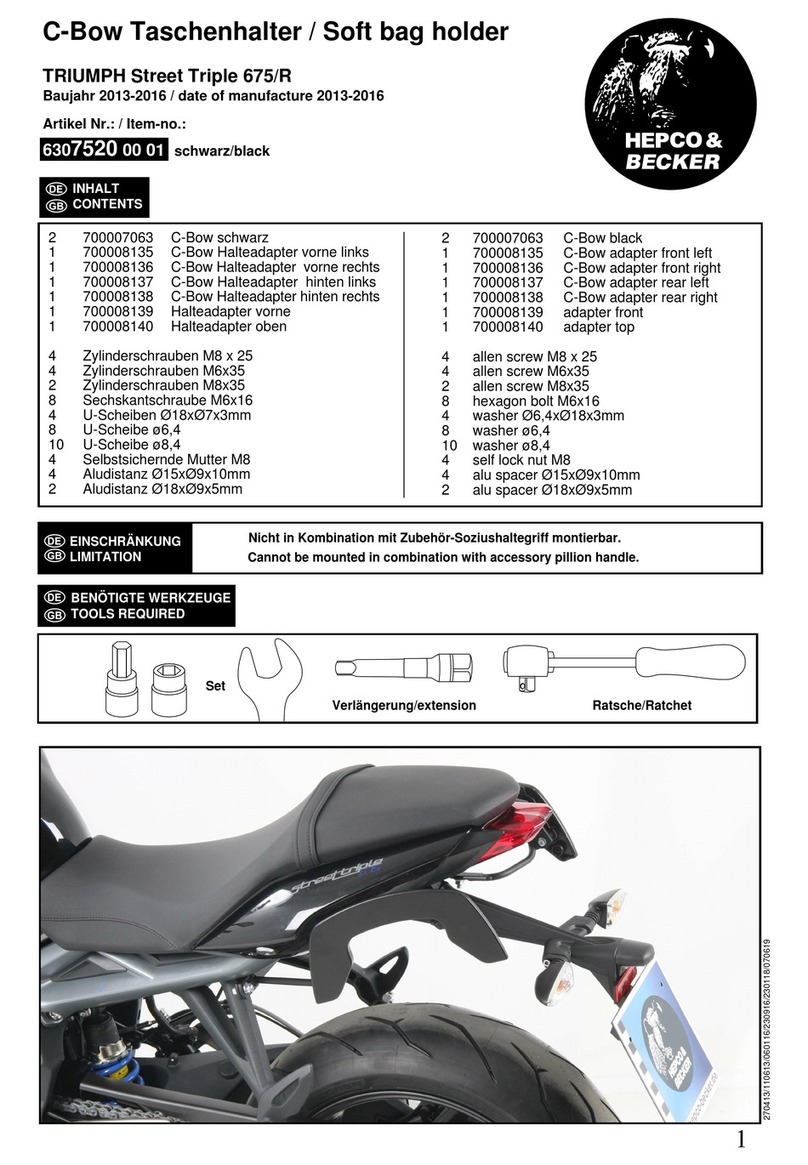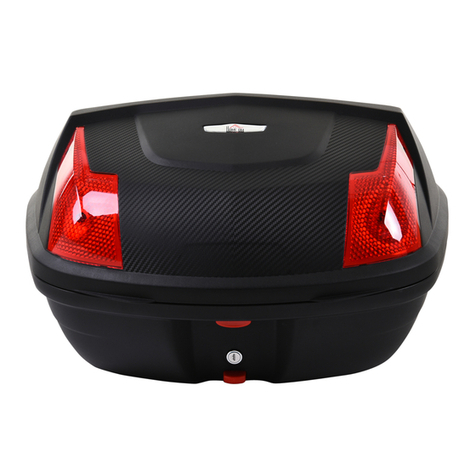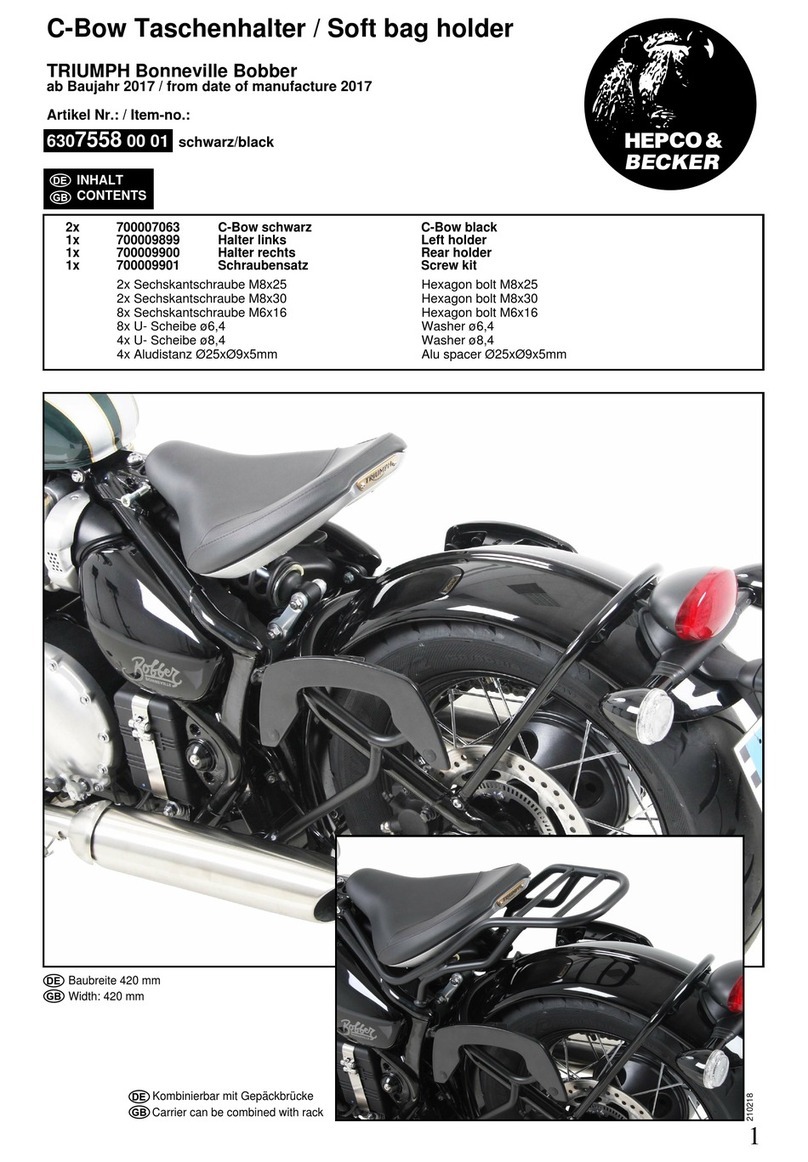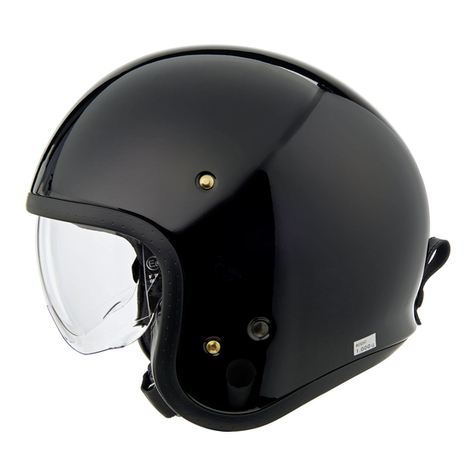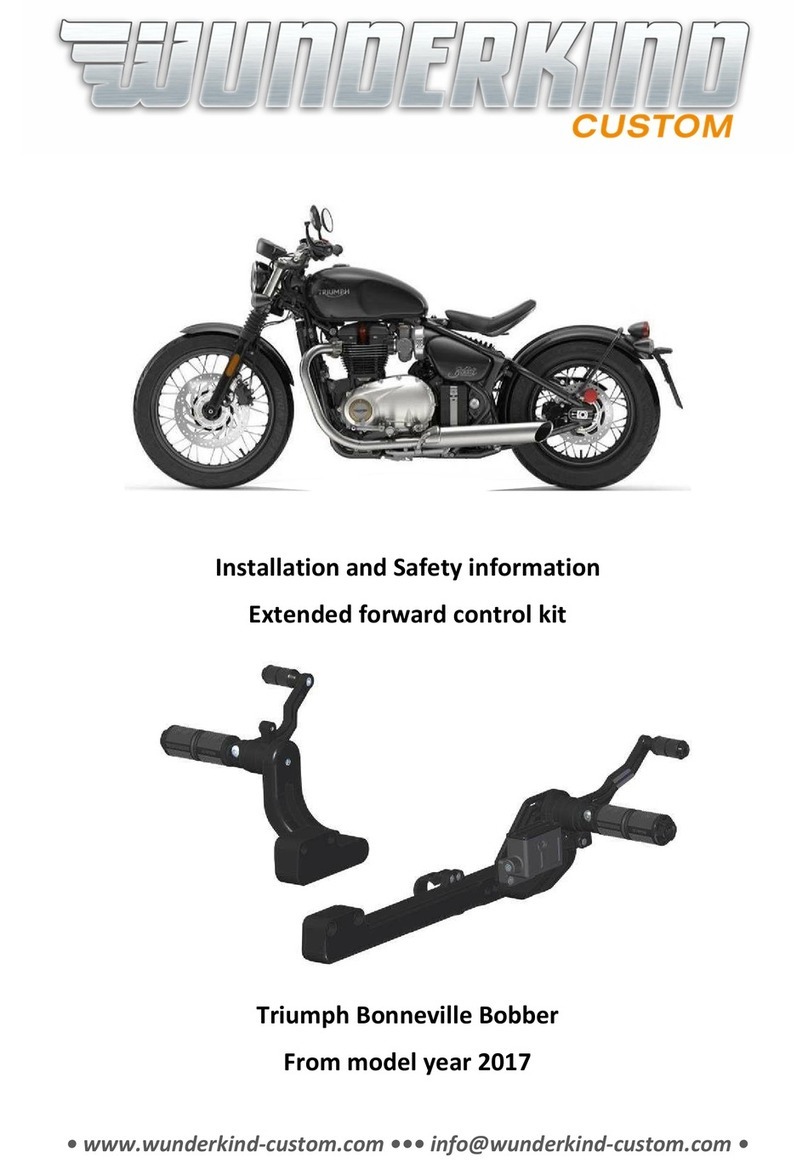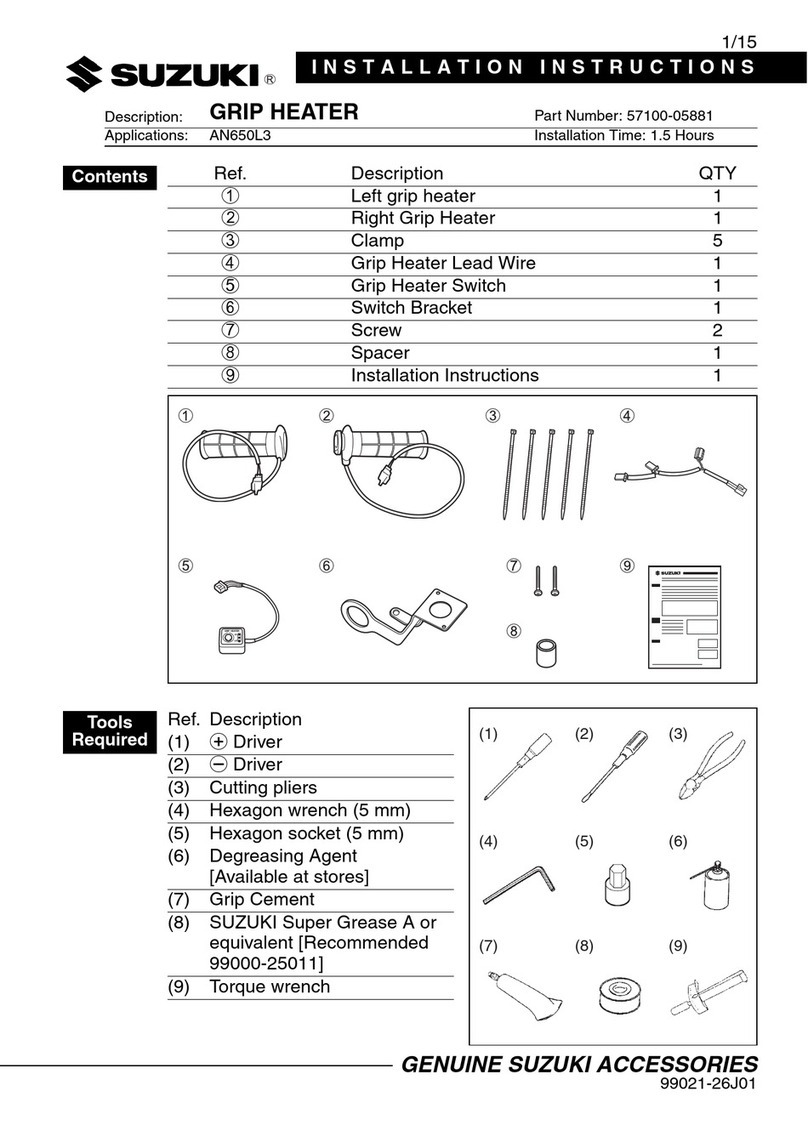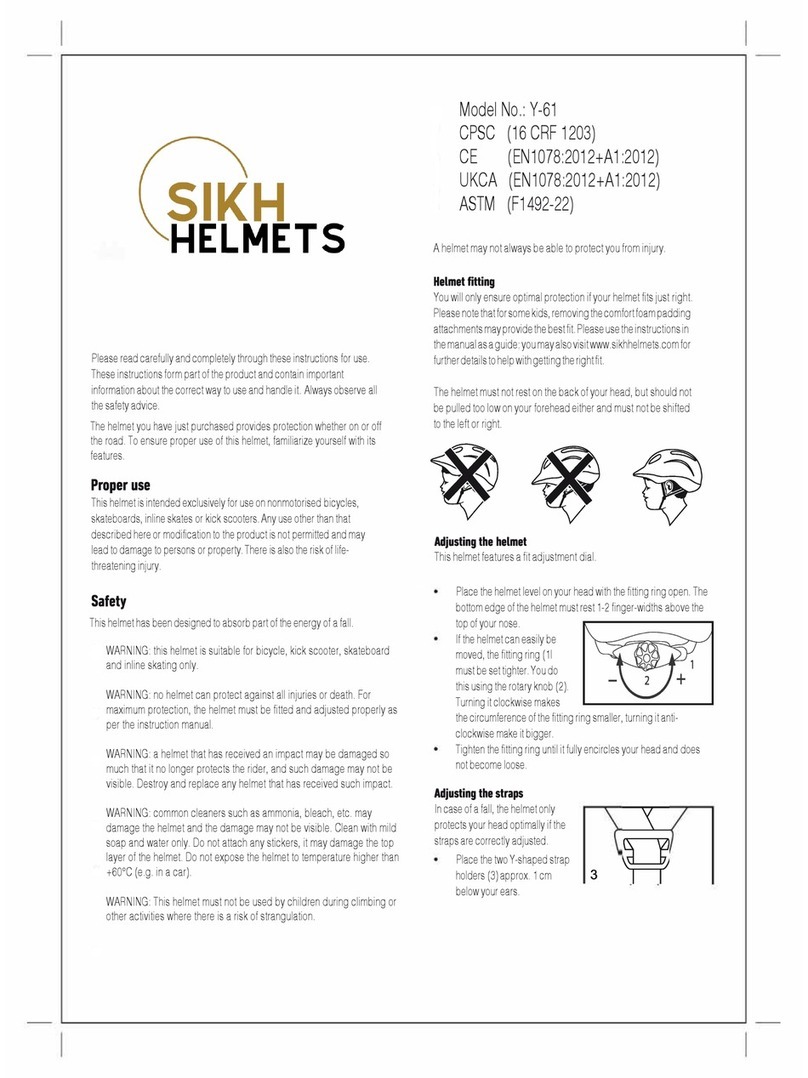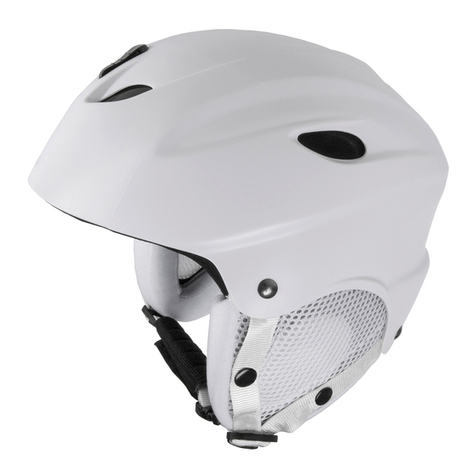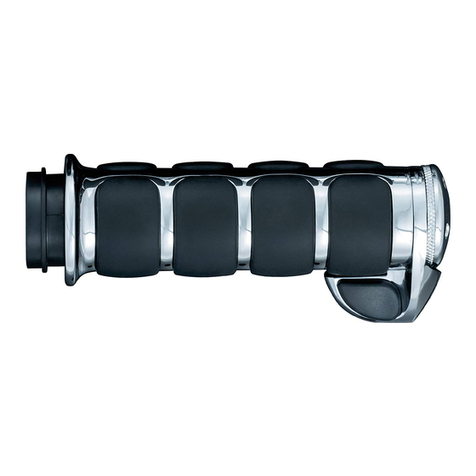Wilbers 303 User manual

Montage- und
Bedienungsanleitung
für Wilbers Cartridge Satz
Typ 303 (RSU Gabeln)
Installation and
operation manual
for the Wilbers cartridge
set type 303 (RSU fork)
Made in Germany

Hinweis:
Sollten Sie sich beim Umbau unsicher sein oder nicht über das notwendige Werkzeug
verfügen, wenden Sie sich an einen Wilbers Stützpunkt bzw. eine Fachwerkstatt und
lassen die Montage dort durchführen.
Das fahrzeugspezifische Werkstatthandbuch bzw. die Bedienungsanleitung kann bei
der Montage hilfreich sein. Verwenden Sie immer die hier vom Hersteller vorgegebenen
Anzugsmomente.
1. Demontage der Originalgabel
1.1
Sorgen Sie für einen sicheren und festen Stand Ihres Motorrades. Heben Sie das
Motorrad mittels eines Montageständers soweit an, dass das Vorderrad den Boden
nur noch leicht berührt.
1.2
Entfernen Sie die Bremssättel, das Vorderrad
und den Vorderradkotflügel.
1.3
Wenn Ihr Motorrad mit einem ABS aus-
gestattet ist, so demontieren Sie nun den
ABS Sensor von der Achsaufnahme.
1.4
Messen Sie den Gabelüberstand (A) an der
oberen Gabelbrücke und notieren Sie sich
diesen Wert. Lösen Sie nun die Schrauben
(2/3) an der oberen und unteren Gabel-
brücke. Ziehen Sie die Gabelholme (1) aus
den Gabelbrücken heraus.
2.1
Gabelholm mit Schutzbacken in Schraub-
stock einspannen. Gabelverschlussdeckel (1)
aus dem Standrohr herausschrauben. Nun
Vorspannhülse (2), Stützring (3) und Gabelfe-
der (4) demontieren.
2.2
Öl aus dem Gabelholm in einen geeigneten
Behälter leeren. Das Standrohr mehrmals auf
und ab bewegen um restliches Öl abfließen
zu lassen.
2.3
Lösen Sie die Schraube (1) im Tauchrohr.
2.4
Dämpferrohr (2) mit Kolbenring (1) und Feder
(3) demontieren.
2.5
Staubkappe (1) vorsichtig lösen und nach
oben schieben. Sicherungsring (2) demon-
tieren. Tauchrohr von außen vorsichtig mithilfe
einer Lötlampe oder Heißluftpistole im oberen
Bereich (Pfeil) erhitzen. Standrohr (6) etwas
einschieben, dann mit einem starken Ruck
nach oben ziehen um es mit Simmerring (3),
Zwischenscheibe (4) und Gleitbuchse (5) zu
demontieren. Hydrostop (7) demontieren.
Montage
24
1
1
2
3
1
2
1
2
3
4
3
1
2
3
4
5
6
7
Grafiken: BMW Motorrad Grafiken: BMW Motorrad
2. Zerlegen der Originalgabel

3. Montage von Wilbers Standrohr und Cartridge
3.1
Die zuvor vom original Standrohr demontierte
Gleitbuchse (1) auf Beschädigungen wie
Schleifspuren und Abrieb der Beschichtung
prüfen und ggf. ersetzen. Gleitbuchse auf
Wilbers Standrohr montieren.
3.2
Tüte (1) über Wilbers Standrohr (2) stülpen
um den Simmerring nicht an scharfen Kanten
zu beschädigen.
3.3
Wilbers Standrohr (6) in Tauchrohr ein-
setzen. Gleitbuchse (5) auf Beschädi-
gungen wie Schleifspuren und Abrieb auf der
Beschichtung prüfen, ggf. ersetzen und mit
Zwischenring (4) mithilfe von Einschlagwerk-
zeug (200-0007-43) montieren.
Simmerring (3) mit großer Vertiefung nach
unten (Pfeil) mithilfe von Einschlagwerkzeug
(200-0007-43) montieren.
Sicherungsring (2) montieren. Fetttasche
der Staubkappe (1) mit Antireibungsfett
(585-0999-00) füllen und montieren.
3.4
Um das Wilbers Cartridge im Gabelholm
montieren zu können muss es zunächst
zerlegt werden. Gehen Sie wie folgt vor:
Kunststoffhülse (3) hinunter drücken und
einen Kontermutterhalter (200-0010-00)
zwischen Kontermutter (7) und Kunststoff-
hülse (3) einsetzen. Nun den Gabelver-
schlussdeckel (1) demontieren, während Sie
dabei an der Kontermutter (7) gegenhalten.
Entfernen Sie im Anschluss den Konter-
mutterhalter, Hülsen (2/3), Stützscheiben (4),
Gabelfeder (5), und Regulierstange (6).
Hinweis:
Der Wilbers Cartridge Satz ist unterteilt in Druckstufe und Zugstufe. Montieren Sie das
Druckstufen-Cartridge (roter Skalenring) im linken und das Zugstufen-Cartridge (gelber
Skalenring) im rechten Gabelholm.
3.5
Setzen Sie nun das Wilbers Cartridge (1) in den
Gabelholm (2) ein.
Grafiken: BMW Motorrad Grafiken: BMW Motorrad
1
1
1
2
1
2
3
4
5
6
7
1
2
3
4
5
6
2
3

3.9
Bauteile wieder in folgender Reihenfolge mon-
tieren:
(4) Stützscheibe unten
(5) Wilbers Gabelfeder
(4) Stützscheibe oben
(6) Regulierstange
3.10
Setzen Sie nun die Kunststoffhülse (3) ein
und drücken Sie diese hinunter. Setzen
Sie den Kontermutterhalter zwischen Kon-
termutter (4) und Kunststoffhülse (3) ein.
Montieren Sie die Hülse (2) und schrauben
den Gabelverschlussdeckel (1) langsam auf,
bis er leicht auf Block sitzt. Gabelverschluss-
deckel (1) mit Kontermutter (4) kontern.
Prüfen Sie, ob sich die Einstellschraube
zur Justierung der Dämpfung um 10 Klicks
verstellen lässt. Bei zu wenigen Klicks muss
der Gabelverschlussdeckel (1) höher und bei
zu vielen Klicks tiefer positioniert werden.
Hierzu Kontermutter (4) nochmals lösen und
Höhe korrigieren.
3.6
Schraube (1) mit Loctite 243 mittelfest ver-
sehen und zusammen mit Dichtring (2) das
Cartridge im Tauchrohr montieren. Dabei das
Cartridge gegen Verdrehung fixieren.
Ziehen Sie die Schraube (1) mit einem
Anzugsdrehmoment von 20 Nm fest.
3.7
Befüllen Sie den Gabelholm zu 2/3 mit dem
in der Garantiekarte empfohlenen Wilbers
Gabelöl. Die korrekte Luftkammer wird erst
nach dem Entlüftungsvorgang eingestellt.
Entlüften Sie zunächst den Gabelholm,
indem Sie das Standrohr mehrmals auf- und
abbewegen. Dabei sollte bei der Aufwärts-
bewegung die Handfläche das Standrohr
verschließen, um ein Vakuum zu erzeugen. Im
Anschluss mithilfe eines Cartridgeentlüfters
(200-0008-00), welcher auf die Kolbenstange
aufgeschraubt wird, das Cartridgesystem
durch mehrmaliges auf- und abbewegen
der Kolbenstange so lange entlüften, bis die
Dämpfung deutlich spürbar einsetzt.
3.8
Das Standrohr und die Kolbenstange voll-
ständig absenken. Unter Verwendung ei-
nes Füllmessstabes die in der Garantiekarte
notierte Luftkammer einstellen und über-
schüssiges Öl absaugen.
Grafiken: BMW Motorrad Grafiken: BMW Motorrad
1
2
1
1
2
2
3
4
5
6
7
3
4

3.11
Entfernen Sie den Kontermutterhalter, schieben
Sie das Standrohr (2) nach oben und schrau-
ben Sie den Gabelverschlussdeckel (1) ein.
Ziehen Sie diesen mit einem Anzugsmoment
von 20 Nm fest. Stellen Sie die Einstellschraube
zur Justierung der Dämpfung jeweils auf der in
der Garantiekarte vermerkten Position ein.
3.12
Montieren Sie den Wilbers Gabelholm mit
Zugstufenverstellung (gelber Skalenring)
rechts und den Gabelholm mit Druckstu-
fenverstellung (roter Skalenring) links in der
Gabelbrücke. Stellen Sie, wenn nicht anders
angegeben, den Standard Gabelüberstand
ein. Ziehen Sie dann die Schrauben (2/3) der
oberen und unteren Gabelbrücke nach Vor-
gabe des Fahrzeugherstellers fest.
3.13
Befestigen Sie ggf. den ABS-Sensor an
der Wilbers Gabel unter Verwendung der
Originalhalterung. Montieren Sie nun den
Kotflügel, das Vorderrad und die Brems-
sättel. Ziehen Sie die Schrauben der
Radachsenklemmung noch nicht fest.
3.14
Stellen Sie das Motorrad auf den Boden.
Betätigen Sie die Vorderradbremse und
drücken Sie das Motorrad dabei 3 bis 4 x in
die Federung hinein. Dies dient dazu, dass
sich die Gabelholme parallel und spannungs-
frei auf der Radachse ausrichten. Ziehen Sie
erst jetzt alle Schrauben des Vorderrades
nach Vorgabe des Fahrzeugherstellers fest.
Bedienungs- und Einstellanleitung
Hinweis:
Ihr Wilbers Cartridge Satz wurde speziell für Ihr Motorrad und Ihre Bedürfnisse entwickelt
und abgestimmt. Aus diesem Grund sollte es nur an Ihrem Modell, welches weitest-
gehend dem Serienzustand entspricht, verbaut werden.
Führen Sie nach dem Einbau eine Testfahrt auf einer Ihnen bekannten Strecke bei lang-
samer Geschwindigkeit durch, um das Fahrverhalten Ihres Motorrades zu überprüfen.
Sollten Sie Änderungen an der Grundeinstellung der Gabel vornehmen, so empfehlen
wir, diese in kleinen Schritten vorzunehmen und nach jeder Änderung ebenfalls die Test-
strecke abzufahren.
Federvorspannung:
Die Federvorspannung kann über den Sechskant (2) mit einem Ringschlüssel (SW17)
justiert werden. Der Verstellbereich beträgt 10 mm, wobei der Abstand zwischen
zwei Ringen jeweils 2 mm beträgt. Diese dienen der einfacheren und gleichmäßigen
Einstellung an beiden Gabelholmen. Die Grundeinstellung können Sie der beiliegenden
Garantiekarte entnehmen.
2
2
2
4
1
1
3
Grafiken: BMW Motorrad

Da die Feder und deren Vorspannung für das Fahrzeugniveau ausschlaggebend sind,
beeinflussen sie auch das Fahrverhalten des Fahrzeugs. Die richtige Federvorspannung
ist entscheidend für das Handling Ihres Motorrades.
Daher ist es unerlässlich, dass Sie vor Antritt der ersten Fahrt und nach jeder Verstellung
der Vorspannung die Negativfederwege überprüfen. Gehen Sie dabei wie folgt vor:
1. Heben Sie das Motorrad mit Hilfe eines Montageständers komplett aus der Feder,
sodass das Vorderrad frei über dem Boden schwebt.
2. Am Vorderrad dient die sichtbare Länge des Gabelinnenrohres als Messstrecke.
Ermitteln Sie den hier als „A“ bezeichneten Wert.
3. Stellen Sie das Motorrad nun senkrecht zur Fahrbahn auf den Boden und federn
es einige Male durch. Eine zweite Person misst nun die neue Länge der festgelegten
Messstrecke, hier als Wert „B“ bezeichnet.
Die Differenz der beiden Werte („A“ – „B“) ergibt den statischen Negativfederweg N1.
4. Im nächsten Schritt setzen Sie sich auf das Motorrad und nehmen soweit wie möglich
Ihre Fahrhaltung ein. Die zweite Person misst erneut den Abstand der Messstrecke, hier
als Wert „C“ bezeichnet.
Die Differenz zum Ausgangswert („A“ – „C“) ergibt den dynamischen Negativfederweg
N2.
A
B
C
Zu folgenden Ergebnissen sollten
Sie kommen:
Statischer Negativfederweg N1:
20 - 30 mm
Dynamischer Negativfederweg N2:
30 - 40 mm
Druck- und Zugstufeneinstellung:
Bei dem Wilbers Cartridge Satz sind
Zug- und Druckstufeneinstellung jeweils
getrennt voneinander in einem Holm
untergebracht. Dabei sind die Zug-
stufenseite mit einem gelben und
die Druckstufenseite mit einem roten
Skalenring gekennzeichnet. Die Dämp-
fung kann unter Verwendung eines
Schlitzschraubendrehers an den Einstell-
schrauben (3) variiert werden. Zusätzlich
zeigt eine kleine Kerbe die Position der
Einstellung an. Die Grundeinstellung
können Sie der beiliegenden Garantie-
karte entnehmen.
Dabei gilt jeweils: 1 minimale Dämpfung / 10 maximale Dämpfung
Hinweis:
Die Druckstufendämpfung wirkt Feder unterstützend, dämpft also die Einfeder-
bewegung. Das bedeutet, dass hiermit das Ansprechverhalten der Gabel bzw. das
Feedback des Fahrzeugs zur Straße im Wesentlichen beeinflusst wird. Je geringer die
Dämpfung, desto besser können Stöße absorbiert werden. Umso höher die Dämpfung,
desto eher werden Stöße ins Fahrwerk eingeleitet.
Die Zugstufendämpfung reguliert die Ausfedergeschwindigkeit der Gabel. Sie sollte
so justiert werden, dass die Gabel maximal schnell ausfedert und nur ganz leicht
nachschwingt. Somit ist gewährleistet, dass das Vorderrad immer den vollen Kontakt
zur Fahrbahn hält.
3
1. Überprüfen Sie, ob Öl aus der Gabel austritt.
2. Überprüfen Sie das innere Gabelrohr auf Kratzer, Dellen oder ähnliche Beschä-
digungen, da dies die Simmerringe beschädigen kann.
3. Überprüfen Sie die Befestigungspunkte der Bremszangen und des Kotflügels.
Führen Sie diese Sichtkontrolle regelmäßig, einmal im Jahr, oder alle 5.000 km aus.
Sollte Ihnen dabei ein Schaden oder Mangel auffallen, so kontaktieren Sie bitte einen
Wilbers Stützpunkthändler oder wenden sich direkt an uns.
Zum Wert- und Funktionserhalt Ihrer Wilbers Gabel / Cartridge Satz empfehlen wir die
Wartungsintervalle von 20.000 km oder zwei Jahren einzuhalten.
Inspektion und Wartung

Attention:
In case that you are unsure, or do not have the necessary tools, visit a Wilbers service
point respectively an expert garage and let them do the installation.
The vehicle specific workshop manual and operation instruction can be useful during
installation. Always use the torques indicated by the manufacturer.
1. Dismounting the original fork
1.1
Care for a safe and secure stand of the motorcycle. Lift the motorcycle with the help of
an assembly stand so that the front wheel only barely touches the ground.
1.2
Remove the brake callipers, the front wheel
and the front wheel fender.
1.3
If your motorcycle is equipped with ABS de-
mount the ABS sensor from the axle mount.
1.4
Measure the fork protrude (A) on the up-
per fork bridge and write it down. Loosen
screws (2/3) on both, the upper and lower
fork bridge. Pull the fork tubes (1) from the
fork bridges.
2.1
Fasten the fork leg in a vice with protective
clamps. Unscrew the fork cap (1) from the
tube. Now demount preload spacer (2), sup-
porting ring (3) and fork spring (4).
2.2
Empty the oil from the fork tube into a suita-
ble container. Do this by moving tube up and
down repeatedly to completely bleed the
system.
2.3
Loosen the screw (1) inside the inner tube.
2.4
Demount damper rod (2) with piston ring (1)
and spring (3).
2.5
Carefully remove the dust cap (1) and push it
upwards. Demount the safety ring (2). Heat
the inner fork tube from the outside at the top
area (arrow) using a blowtorch or heat-gun.
Push the outer tube inside a bit (6), then, pull
it upwards forcefully to demount fork seal (3),
spacer (4) and floating bearing (5). Demount
hydro-stop (7).
Installation
24
1
3
1
2
3
1
2
1
2
3
4
1
2
3
4
5
6
7
2. Dismantling the original fork
Graphics: BMW Motorrad Graphics: BMW Motorrad

3. Mounting the Wilbers fork tube and cartridge
3.1
Check the earlier dismounted floating bearing
(1) for damages such as scrub marks and
abrasion of the coating and replace it if ne-
cessary. Install the floating bearing onto the
Wilbers fork tube.
3.2
Put a plastic bag (1) on top of the Wilbers fork
(2) not to harm the fork seals on sharp edges.
3.3
Insert the Wilbers tube (6) into the original
outer tube. Check the bearing (5) for stress
marks and abrasion of the coating and repla-
ce it if necessary and mount it together with
the spacer (4) using the installation tool (200-
0007-43).
Mount the fork seal (3) with the bigger cavity
pointing upwards (arrow) using the installati-
on tool (200-0007-43).
Mount the safety cap (2). Fill the grease
chamber of the dust cap (1) with anti-friction-
grease (585-0999-00) and install the cap.
3.4
To install the Wilbers cartridge into the fork
tube, dismantle it first. Do this as follows: push
down the plastic tube (3) and put a lock-nut-
holder (200-0010-00) between lock-nut (7)
and plastic tube (3). Now demount the fork
cap (1) while countering it at the lock-nut (7).
After that, remove the lock-nut-holder, the tu-
bes (2/3), protection washers (4), fork spring
(5) and rod (6).
Attention:
The Wilbers cartridge set is divided in compression and rebound. Mount the compres-
sion-cartridge (red scale-ring) into the left and the rebound-cartridge (yellow scale-ring)
into the right fork tube.
3.5
Now, install the Wilbers cartridge (1) into the
fork tube (2).
Graphics: BMW Motorrad Graphics: BMW Motorrad
1
1
1
2
1
2
3
4
5
6
7
1
2
3
4
5
6
3
2

3.9
Remount parts in the following order:
(4) Lower supporting washer
(5) Wilbers fork spring
(4) Upper supporting washer
(6) Regulation rod
3.10
Now insert the plastic washer (3) and push
it down. Position the counter-nut-holder bet-
ween counter-nut (4) and plastic washer (3).
Mount the bushing (2) and slowly screw on
the fork-cap (1) until it touches block, i.e. tigh-
ten it hand-tight. Counter the fork-cap (1) with
the counter-nut (4). Check if the adjustment
screw for calibrating the damping can be tur-
ned by 10 clicks. In case of too few clicks
the fork-cap (1) has to be set higher and in
case of too many clicks it must be positioned
lower. To do this loosen the counter-nut (4)
again and correct the height.
3.6
Coat screw (1) with loctide 243 (middle-
strong) and install the cartridge into the fork
tube together with the seal ring (2). Fixate the
cartridge against twisting. Tighten the screw
(1) with a torque of 20 N/m.
3.7
Fill the fork tube for 2/3 with the Wilbers fork
oil recommended on the warranty paper. The
correct air chamber is only set after bleeding
the system. First bleed the fork leg by moving
the tube upward and downward a couple of
times. Here, while moving upward, the palm
of the hand should seal the tube to create
a vacuum. After that, using the cartridge-
bleeder that is to be screwed onto the piston
shaft, bleed the cartridge-system by repea-
tedly moving the shaft up and down until the
damping can be noticeable felt.
3.8
Completely lower tube and piston shaft. By
using a measuring device set the air cham-
ber as indicated on the warranty paper and
remove the excessive oil by suction.
Graphics: BMW Motorrad Graphics: BMW Motorrad
1
2
1
1
2
2
3
4
5
6
7
3
4

3.11
Remove the counter-nut-holder, move the tube
(2) upward and fasten the fork-cap (1). Tighten
it with a torque of 20 N/m.
Set the adjustment screw for calibrating the
damping to the respective position recommen-
ded on the warranty paper.
3.12
Mount the Wilbers fork tube with rebound
adjustment (yellow-ring) into the right side
and the compression adjustment (red-ring)
into the left side of the fork-bridge and set
it, if not indicated differently, to the standard
fork protrude. Tighten the screws (2/3) of the
upper and lower fork bridge as specified in
the vehicle manual by the manufacturer.
3.13
If applicable fasten the ABS sensor to the
Wilbers fork using the original bracket. Now
remount the fender, front wheel and brake
callipers. Do not yet fasten the wheel axle
clamp.
3.14
Put the motorcycle on its wheels. Hold the
front wheel brake and push the motorcycle
3-4 times into the fork damping. This is to
move the fork tubes into a parallel and tensi-
on-free positi¬on on the wheel axle.
Setup manual
Attention:
Your Wilbers cartridge set has been especially developed and setup for your motor-
cycle and your requirements. For this reason it should only be installed into your motor-
cycle model that has been kept in its original condition as far as possible.
After installation, make a test drive on a familiar road at slow speed to check the riding
behavior of your motorcycle. If you make changes to the basic adjustments of the fork,
we recommend doing those changes in small steps and to again check for optimal
functionality on the familiar test track.
Spring preload:
The spring preload can be set over the hexagonal screw (2) using a mouth width
(SW17). The adjustment range is 10 mm and the distance between each marker-ring
is 2 mm. This serves the easy and constant adjustment on both fork tubes. The basic
setup is listed in the warranty papers.
2
2
2
4
1
1
3
Graphics: BMW Motorrad

Because the spring and its preload are essential for the riding geometry, they influence
the riding behavior – the correct spring preload is crucial for the handling of your
motorcycle. Therefore it is necessary to check the spring preload and the fork sags
before every ride. Do do this, follow these steps:
1. Completely lift the motorcycle off the spring so that the front-wheel freely hovers
above the ground.
2. On the front wheel the visible length of the inner fork tubes serves as a measuring
distance. Determine the value here called “A“.
3. Now put the motorcycle on the ground vertical to the road surface and push the fork
down a couple of times. A second person now measures the new length of the inner
tube and marks it as “B”.
The difference between those two values (“A“ – “B“) yields the static sag N1.
4. In the next step sit on the motorcycle in your normal riding position as much as
possible. The second person now again measures the defined distance that is here
called “C“. The difference between those two values (“A“ – “C“) yields the dynamic
sag N2.
A
B
C
Compression- and rebound-adjustment:
With the Wilbers cartridge set, compres-
sion- and rebound-adjustment are kept
separately in different fork tubes. While
the rebound side is marked with a yellow
scale-ring, the compression side shows
a red scale-ring. The damping can be
modified using a slotted screwdriver at
the adjustment screws (3). Additionally
a small notch indicates the adjustment
position. Find the basic settings on the
included warranty card.
Rule of thumb: 1 minimum damping / 10 maximum damping
Attention:
The compression damping supports the spring, thus damping the inward movement
of the fork. This means that it essentially influences the response characteristics of the
fork and the feedback of road to the motorcycle. The smaller the damping, the better
jolts can be absorbed. Consequently, the higher the damping the easier jolts are led
into the suspension.
The rebound damping regulates the outward movement of the fork. It should be set
so that the fork rebounds as quickly as possible and only oscillates very softly. This
guarantees that the front wheel always has full contact to the road surface.
3
Inspection points
1. Check if oil exits from the fork.
2. (Please) Check the inner fork tubes for scratches, dents or similar changes,
as whose might damage the oil seals.
3. Check the mounting points of the brake calliper and the fender.
Regularly undergo this inspection once a year or all 5.000 km.
If you find damage or fault, contact your Wilbers service point dealer or inform us
directly.
For value- and function-upkeep of your Wilbers fork / cartridge set, we recommend
keeping the service intervals of every 2 years or 20.000 km.
Inspection and service
You should reach the following results:
Static sag N1:
20 - 30 mm
Dynamic sag N2:
30 - 40 mm


Wilbers Products GmbH
Frieslandstr. 10 · 48527 Nordhorn
Telefon: +49 (0)5921 72717-0
Telefax: +49 (0)5921 74099
Table of contents
Languages:

